Half empty glass
On Habré, a new heading has been mentioned: What if Rendela Munro ( xkcd ). Every Tuesday, he answers various foolish questions from readers in terms of the laws of physics. Below is a translation of one of the issues.
What if the glass suddenly becomes literally half empty?
—Vittorio Iacovela
As it turns out, the pessimist in this case will be right. When they say "a glass is half empty," they usually mean that a glass contains equal water and air.

It is believed that the optimist glass seems half full, while the pessimist finds it half empty. This parable gave rise to a whole bunch of humorous variations (the engineer sees a glass that is designed with a double capacity reserve; a surrealist sees a giraffe chewing a tie, etc.)
But what if the empty half of the glass really became empty — that is, containing a vacuum? (They say even the vacuum is not empty, but we will leave this question to quantum physicists).
Vacuum, of course, does not last long. But what will happen to him depends on the answer to the question that people usually forget to ask: which half of the glass is empty?
')
For our study, we present three half-empty glasses and see what happens to them, nanosecond by nanosecond.
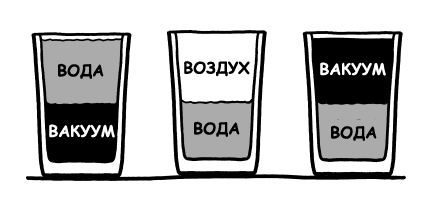
In the center is a classic glass of water and air. On the right is a variant similar to the first, only instead of air in a glass is a vacuum. In the glass on the left, the bottom half is empty.
Suppose a vacuum is formed at time t = 0.

The first few nanoseconds nothing happens. At this time even air molecules are almost immobile.
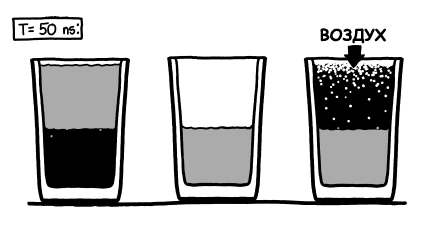
Most of the time, air molecules rush around at a speed of several hundred meters per second. But at any given time, some of them can move faster than others. A couple of the fastest speeds of over 1000 m / s. It is these molecules that will first fly into the vacuum of the glass on the right.
The vacuum in the glass on the left is surrounded on all sides by obstacles, so it’s not so easy for air molecules to get there. Water, being a liquid, does not expand to fill the void that has arisen, as air does. However, on the border with vacuum, water begins to boil, gradually throwing steam into the lower part of the glass.

While the water in both glasses begins to boil, in the right glass the air penetrating inside does not allow the water to flow properly. The glass on the left continues to be filled with a light mist from boiling water.
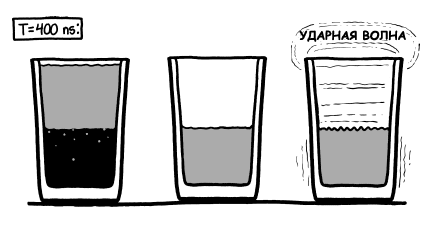
After a few hundred nanoseconds, the air rushing into the glass on the right completely fills the vacuum and crashes into the surface of the water, sending a shock wave through the liquid. The walls of the glass shake slightly, but withstand the pressure and do not fight. The shock wave is reflected from the water back into the air, contributing to the turbulence that has already occurred there.
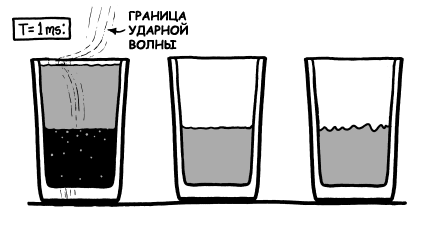
The shock wave resulting from the collapse of the vacuum takes about 1 ms to reach the other two glasses. The glass and water bend slightly as the wave passes through them. After a few milliseconds, the wave reaches the human ear in the form of a loud bang.

Around the same time, the glass on the left begins to rise markedly upwards.
Air pressure is trying to squeeze a glass and water. This is the power that we are used to perceive as absorption. The vacuum in the glass on the right did not stretch long enough for the suction to lift the glass, but since the air cannot penetrate the vacuum on the left, the glass and water begin to move towards each other.

Boiling water filled the vacuum with a very small amount of water vapor. As the empty space shrinks, the mass of water vapor gradually increases the pressure on the surface of the water. Over time, this process will weaken the boiling, as it would have happened with an increase in atmospheric pressure.

However, by this time the glass and the water are moving towards each other too fast for the steam to have any meaning. Less than 10 ms after the start of the countdown, they rush towards each other at a speed of several meters per second. In the absence of a softening layer of air between them - only pitiful remnants of steam - water crashes into the bottom of the glass, like a sledgehammer.

Water is practically unable to shrink, so the collision is not stretched in time - it occurs as one sharp blow. The glass does not withstand enormous pressure and bursts.
This “water hammer” effect (also leading to a thud in the old water supply when the faucet is closed) can be seen in a well-known rally (reproduced by the Legends of Destroyers, studied in physics classes, demonstrated at countless parties), when a sharp blow to the neck of the bottle knocks her bottom .
When hit on the bottle, it sharply pushed down. The fluid inside can not react to the increased air pressure instantly - as in our case - and for a short time there is a gap. This is a very thin gap - only a centimeter thick - but when it collapses, the blow knocks the bottom off the bottle.
In our case, the strength will be enough to break even the most durable glass.

Water pulls the bottom of the glass down and imprints it on the surface of the table. Water is poured over the table, splashing drops and pieces of glass in all directions.
And at this time, left alone, the top of the glass continues to take off.

After half a second, observers, having heard the clap, start. Their heads involuntarily rise, following the soaring glass.
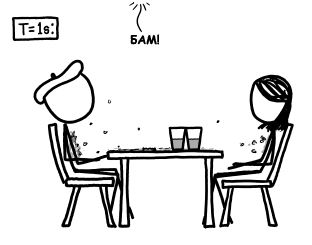
The glass has enough speed to break on the ceiling, flying apart into shards ...

... who are now returning to the table.
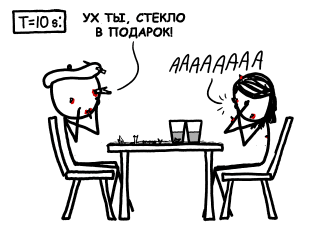
Conclusion: if the optimist says that the glass is half full, and the pessimist - that it is half empty, the physicist hides under the table.

What if the glass suddenly becomes literally half empty?
—Vittorio Iacovela
As it turns out, the pessimist in this case will be right. When they say "a glass is half empty," they usually mean that a glass contains equal water and air.

It is believed that the optimist glass seems half full, while the pessimist finds it half empty. This parable gave rise to a whole bunch of humorous variations (the engineer sees a glass that is designed with a double capacity reserve; a surrealist sees a giraffe chewing a tie, etc.)
But what if the empty half of the glass really became empty — that is, containing a vacuum? (They say even the vacuum is not empty, but we will leave this question to quantum physicists).
Vacuum, of course, does not last long. But what will happen to him depends on the answer to the question that people usually forget to ask: which half of the glass is empty?
')
For our study, we present three half-empty glasses and see what happens to them, nanosecond by nanosecond.

In the center is a classic glass of water and air. On the right is a variant similar to the first, only instead of air in a glass is a vacuum. In the glass on the left, the bottom half is empty.
Suppose a vacuum is formed at time t = 0.

The first few nanoseconds nothing happens. At this time even air molecules are almost immobile.

Most of the time, air molecules rush around at a speed of several hundred meters per second. But at any given time, some of them can move faster than others. A couple of the fastest speeds of over 1000 m / s. It is these molecules that will first fly into the vacuum of the glass on the right.
The vacuum in the glass on the left is surrounded on all sides by obstacles, so it’s not so easy for air molecules to get there. Water, being a liquid, does not expand to fill the void that has arisen, as air does. However, on the border with vacuum, water begins to boil, gradually throwing steam into the lower part of the glass.

While the water in both glasses begins to boil, in the right glass the air penetrating inside does not allow the water to flow properly. The glass on the left continues to be filled with a light mist from boiling water.

After a few hundred nanoseconds, the air rushing into the glass on the right completely fills the vacuum and crashes into the surface of the water, sending a shock wave through the liquid. The walls of the glass shake slightly, but withstand the pressure and do not fight. The shock wave is reflected from the water back into the air, contributing to the turbulence that has already occurred there.

The shock wave resulting from the collapse of the vacuum takes about 1 ms to reach the other two glasses. The glass and water bend slightly as the wave passes through them. After a few milliseconds, the wave reaches the human ear in the form of a loud bang.

Around the same time, the glass on the left begins to rise markedly upwards.
Air pressure is trying to squeeze a glass and water. This is the power that we are used to perceive as absorption. The vacuum in the glass on the right did not stretch long enough for the suction to lift the glass, but since the air cannot penetrate the vacuum on the left, the glass and water begin to move towards each other.

Boiling water filled the vacuum with a very small amount of water vapor. As the empty space shrinks, the mass of water vapor gradually increases the pressure on the surface of the water. Over time, this process will weaken the boiling, as it would have happened with an increase in atmospheric pressure.

However, by this time the glass and the water are moving towards each other too fast for the steam to have any meaning. Less than 10 ms after the start of the countdown, they rush towards each other at a speed of several meters per second. In the absence of a softening layer of air between them - only pitiful remnants of steam - water crashes into the bottom of the glass, like a sledgehammer.

Water is practically unable to shrink, so the collision is not stretched in time - it occurs as one sharp blow. The glass does not withstand enormous pressure and bursts.
This “water hammer” effect (also leading to a thud in the old water supply when the faucet is closed) can be seen in a well-known rally (reproduced by the Legends of Destroyers, studied in physics classes, demonstrated at countless parties), when a sharp blow to the neck of the bottle knocks her bottom .
When hit on the bottle, it sharply pushed down. The fluid inside can not react to the increased air pressure instantly - as in our case - and for a short time there is a gap. This is a very thin gap - only a centimeter thick - but when it collapses, the blow knocks the bottom off the bottle.
In our case, the strength will be enough to break even the most durable glass.

Water pulls the bottom of the glass down and imprints it on the surface of the table. Water is poured over the table, splashing drops and pieces of glass in all directions.
And at this time, left alone, the top of the glass continues to take off.

After half a second, observers, having heard the clap, start. Their heads involuntarily rise, following the soaring glass.

The glass has enough speed to break on the ceiling, flying apart into shards ...

... who are now returning to the table.

Conclusion: if the optimist says that the glass is half full, and the pessimist - that it is half empty, the physicist hides under the table.

Source: https://habr.com/ru/post/149212/
All Articles